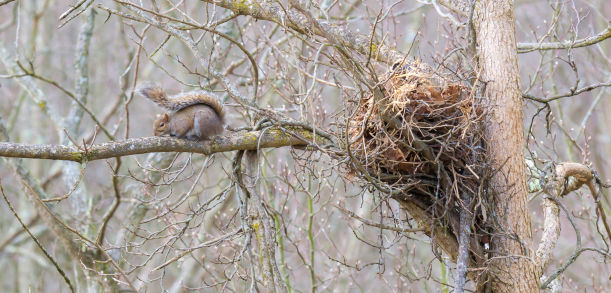Squirrels are hard-working creatures that have figured out how to build strong, insulated nests that shelter them from the wind and cold. These rodents instinctively and independently build their nests to stay warm during the winter and raise their young in the summer. While they are fascinating to observe, it is important that you keep squirrels out of your home. For quality pest-proofing and removal, call Squirrel Control.
Squirrels are very common animals that you might see every day. These are highly adaptable creatures that have learned to live comfortably in human towns and suburbs. The most common species of squirrel in North America is the grey squirrel, which measures up to 30cm in length and has a long, bushy tail that reaches up to 25cm long. The grey squirrel has a white belly and grey fur coat that turns brown in the summertime. Some grey squirrels are entirely black due to a specific gene. Squirrels feed mostly on plant products like seeds, nuts, buds, fruits, and vegetables, but they also like eggs, mushrooms, and insects.
Squirrels are not very social creatures. Males and females will spend some time nesting together during mating season, but then separate for the female to raise the babies on her own. In the winter, squirrels will sometimes share a nest for a little while to withstand the cold. However, if you’ve witnessed multiple squirrels climbing in and out of the same nest, they are probably siblings that have not yet gone their own way. These families consist of a mother and her 2 to 5 pups. Pups usually leave the nest when they are somewhere between 12 and 14 weeks of age.
Squirrels have evolved to build their nests in the forks of tree branches and hollowed trunks, but they unfortunately perceive human houses like trees, as well. To a squirrel, human homes have a tree-like structure in which the roof sticks out above the body of the house like a tree’s canopy. Attics are warm and accessible to squirrels by chewing through plastic vents or any gaps they find on the roof. Squirrels are destructive to attics and pose a fire hazard as they chew on electrical wires. Squirrels also defecate and urinate in their nests, causing odour problems and damaging insulation with mold.
If you suspect a squirrel’s nest in your home, you should remove it with the help of a licensed wildlife removal technician. Nests will not only damage your property but attract other animals to the home, like raccoons and insects. A professional will be able to find the nest, remove it safely, and prevent any more infestations from happening by pest-proofing your home. Call Squirrel Control now for guaranteed squirrel removal and pest-proofing: 647-496-0815.
